Jan Kaplický
Jan Kaplický | |
|---|---|
 | |
| Born | 18 April 1937 |
| Died | 14 January 2009 (aged 71) Prague, Czech Republic |
| Occupation | Architect |
| Awards | Stirling Prize (1999); World Architecture Awards (2001), Royal Institute of British Architects Award for Architecture (2004) |
| Practice | Future Systems |
| Buildings |
|
| Projects | National Library of the Czech Republic, Prague, Czech Republic (commission awarded 2007, cancelled 2008) |
| Design | Neo-Futurism |
Jan Kaplický (/ˈjæn ˈkæplɪtski/; Czech: [ˈjan ˈkaplɪtskiː]; 18 April 1937 – 14 January 2009) was a Neofuturistic[1][2] Czech architect who spent a significant part of his life in the United Kingdom. He was the leading architect behind the innovative design office, Future Systems. He was best known for the neofuturistic Selfridges Building in Birmingham, England, and the Media Centre at Lord's Cricket Ground in London.
Childhood and early life
[edit]Jan Kaplický, the only child of a sculptor and a botanical illustrator,[3] was born on 18 April 1937 in Prague, Czechoslovakia, and grew up in a suburb of Prague called Ořechovka.[4]
Between 1956 and 1962, Kaplický studied at the College of Applied Arts and Architecture and Design (VSUP) in Prague, receiving a Diploma in Architecture. He worked in private practice in Czechoslovakia between 1964 and 1968.[5][6] In the wake of the Prague Spring, the Soviet invasion of Czechoslovakia, he escaped to London in September 1968 with fellow architect Jaroslav Vokoun carrying only US$100 and a few pairs of socks.[7] In 1969 in London, he met Eva Jiřičná again, whom he had known in Prague and became his girlfriend.
Career
[edit]Early career
[edit]In England, Kaplický first worked for Denys Lasdun and Partners (1969–1971), then obtained employment with the office of Renzo Piano and Richard Rogers (1971–1973), where he worked on DRU extension at Aybrook Street, London and later helping to develop the design for the Centre Georges Pompidou (constructed 1971–1977) in Paris by joining the team of more than 30 strong.[8] When the practice relocated to Paris, he was unable to follow as at that time he still did not have a British passport. After working with Jiřičná, and a short spell at Spencer and Webster, Associates (1974–1975), he joined Foster Associates, now Foster and Partners (1979–1983).[3][5]
In 1979, Kaplický set up his own architectural think tank called Future Systems with David Nixon,[9] and began to develop an architectural style that combined organic forms with high tech futurism. Among the drawings he made were structures orbiting the Earth built by robots, weekend houses resembling survival capsules that could be transported by helicopter, and home interiors that could be manipulated. In the 1980s his design for the Grand Buildings in Trafalgar Square, London, was a free-form monocoque structure pierced by portholes; it lost to a more conventional reconstruction of an Edwardian facade.[3] Kaplický told BusinessWeek in 2005: "Where is it written that buildings have to be boxes? People aren't boxes."[9]
Amanda Levete joined Future Systems as a partner in 1989. Kaplický and Levete married in 1991 and were a couple for 15 years; they had a son named Josef.[10] Although they divorced in 2006,[3] they continued their professional association in the architectural practice, saying that the separation strengthened their working relationship.[11]
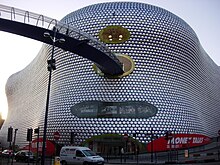

Although Kaplický was a finalist for the Prince Philip Prize for designer of the year in 1991, for the first 15 years of its existence Future Systems, he received few commissions until 1994, where the company was commissioned to build the new media centre at Lord's Cricket Ground which eventually won the Royal Institute of British Architects (RIBA) Stirling Prize – considered the most prestigious architecture award in the UK – in 1999 and the World Architecture Awards in 2001.[9] Kaplický considered the media centre "my favourite creation", saying, "It is something which was revolutionary in many areas – a real technical achievement – but above all, the people operating inside it have said: 'We love it,' and that's great."[12] In 2000, he was made an Honourable Fellow of RIBA.[7][13] Future Systems' next major project, the iconic Selfridges Building in the Bull Ring in Birmingham, won seven awards, including the RIBA Award for Architecture 2004. That year, Kaplický was the subject of a Czech documentary titled Profil (Profile).[14]
Final years and death
[edit]In 2007, Kaplický won the design competition for the new Czech National Library building. This would be his first major building in his home country, and he said the project was the most important event in his life.[15] However, the design for the building, resembling a green and purple blob and nicknamed by locals "the Octopus", was heavily criticised. President of the Czech Republic Václav Klaus was overheard saying he would be willing to prevent the building going ahead with his own body; his spokesman later clarified it was an off-hand remark that had not been meant to be taken seriously.[16] Pavel Bém, the Civic Democrat Mayor of Prague, supported the design when it was selected but later become hostile to it, saying that the City Council of Prague, which is dominated by the Civil Democratic Party, would not allow the Octopus to be built as it would ruin Prague's panorama.[17] Vlastimil Jezek, a former director of the Library, regarded Kaplický as "another protagonist of Czech culture who has been crushed by Czech narrow-mindedness."[6] Although the design was eventually dropped, Kaplický remained hopeful that the building would be built through funds from a private foundation established for this purpose.[18]
Apart from his design work, Kaplický was active in the education of architects. From 1982 to 1988, he taught at the Architectural Association School of Architecture, the oldest independent architectural school in the UK. In 1992, Kaplický taught at the School of Architecture in Bordeaux and at the Design Workshop of the Technische Universität Berlin. He was also an external examiner for the Architectural Association between 1995 and 1998, and in 2000 was an assessor for the Domus Awards of the B.B.J. Competition in Milan.[13]
In October 2008, news broke that Kaplický and Levete intended to go their separate ways after having collaborated professionally for 20 years. Kaplický was due to keep the Future Systems practice name.[19]
Towards the end of his life, Kaplický began to spend more time in the Czech Republic, where he was awaiting the construction of the Czech National Library[3] and where his design for the Congress and Concert Hall Centre in České Budějovice had been approved.[18] He married the film producer[3] Eliška Kaplická (née Fuchsová), in 2007. On 14 January 2009, hours after the birth of his daughter Johanna Kaplická, he collapsed on a street in Prague near Vítězné náměstí (Victory Square) with heart failure and could not be revived by emergency services.[18][20] The city authorities of Budweis have announced their determination to obtain funding to finally build a Kaplický building in his native Czech Republic.[18]
In a 2002 interview with The Observer, Kaplický said: "The world is full of beautiful things, and you have to be observant as an architect – if not, you are in trouble. Creativity is everywhere. ... The initial idea for a job comes to me literally just like that sometimes, and if that first idea is good then you are on the right track. It's not a sign of creativity to have 65 ideas for one problem, that's just a waste of energy. I also don't think you need to go anywhere particular to be creative; people just use that as an excuse. But I do think a lot of creativity depends on your relationships with other people, your personal relationships, your partner or whatever. Your personal happiness or unhappiness comes out in your work, it's a reflection of your emotional state and you can't separate the two."[12]
Major architectural projects
[edit]| Image | Information | Awards |
|---|---|---|
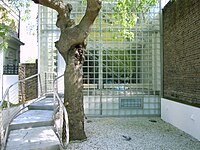
|
Hauer-King House |
|
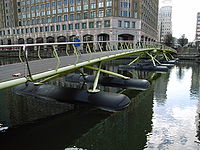
|
West India Quay Bridge |
|

|
Media Centre, Lord's Cricket Ground |
|
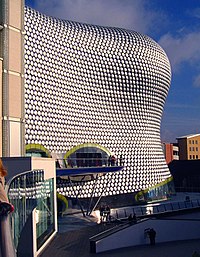
|
Selfridges Building |
|
|
Naples Subway Station |
||
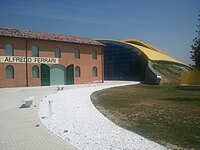
|
Museo Casa Enzo Ferrari |
|
|
National Library of the Czech Republic[21] |
||
|
Congress and Concert Hall Centre |
Notes
[edit]- ^ "If Famous Buildings And Paintings Made Babies, They'd Look Like This". Fastcodesign.com. 5 September 2019. Retrieved 19 March 2017.
- ^ "Artist-Architect Collabos That Never Were". Artnet News. 14 September 2014. Retrieved 19 March 2019.
- ^ a b c d e f Sudjic, Dejan (16 January 2009). "Jan Kaplický: Czech architect whose free-form designs revolutionised British building". The Guardian. Retrieved 9 October 2009.
- ^ "The profile of Jan Kaplický: A documentary by Jakub Wagner introduces Jan Kaplický". Jihlava International Documentary Film Festival. 26 October 2005. Archived from the original on 13 January 2014. Retrieved 13 January 2014.
Jakub Wagner introduces a portrait of Jan Kaplický ... The documentary has been filmed in Great Britain and Prague – at the National Technical Museum and Orechovka Quarter, a place where Kaplický used to live.
- ^ a b "Jan Kaplický". Future Systems. Archived from the original on 4 July 2010. Retrieved 17 January 2009.
- ^ a b "Czech-born architect Kaplicky dies aged 71". ČeskéNoviny.cz. 14 January 2009. Retrieved 17 January 2009.
- ^ a b Ellis Woodman (31 March 2007), "The library has landed", The Daily Telegraph, archived from the original on 12 January 2008
- ^ Martin Pawley, Future Systems, Phaidon, London, 1993, pp. 15–17
- ^ a b c The 1979 date is given inPaggetti, Maria (28 November 2005). "The shape of things to come: Architect Jan Kaplicky on Europe's new keenness for exciting solutions to building designs". BusinessWeek. Archived from the original on 6 March 2008. Retrieved 9 October 2009.. A date of 1982 is mentioned in the Daily Telegraph article.
- ^ Bayley, Stephen (21 January 2009). "Jan Kaplicky: Visionary architect who designed Selfridge's in Birmingham and the Lord's Media Centre". The Independent. Archived from the original on 24 January 2009. Retrieved 9 October 2009.
- ^ Fairs, Marcus. "Future Systems uncovered". Icon. Archived from the original on 29 March 2007.
- ^ a b Mikhail, Kate (22 September 2002). "Jan Kaplicky: 65, Architect best known for the Media Centre at Lord's Cricket Ground". The Observer – via The Guardian.
- ^ a b "Jan Kaplický – CV". Profile.cz (in Czech). Archived from the original on 21 January 2009. Retrieved 17 January 2009.
- ^ "Profil – Jan Kaplický" (in Czech). Czech Television. 14 March 2005. Retrieved 1 April 2007.
- ^ Petaková, Lenka (5 March 2007). "National Library to have new building by Jan Kaplicky". Radio Prague International. Czech Radio. Retrieved 11 August 2008.
- ^ Cameron, Rob (9 May 2007). "Row continues over Kaplicky's "Octopus" design for National Library". Radio Prague International. Czech Radio. Retrieved 11 August 2008.
- ^ Cameron, Rob (18 October 2007). "'Octopus' skewered on political harpoon as Kaplicky, Bem square up for TV clash". Radio Prague International. Czech Radio. Retrieved 11 August 2008.
- ^ a b c d Jůn, Dominik (15 January 2009). "Czechs mourn architect Jan Kaplický". Radio Prague International. Czech Radio. Retrieved 17 January 2009.
- ^ Booth, Robert (15 January 2009). "Radical architect Jan Kaplický dies: Czech-born architect dies only hours after the birth of his daughter and in the midst of a battle to begin work on his national library in Prague". The Guardian. Retrieved 9 October 2009.
- ^ "Czech architect Kaplický dies in Prague aged 71". Aktuálně.cz. Economia. 15 January 2009. Retrieved 17 January 2009.
- ^ "Britain's Future Systems wins design competition for building Czech National Library", International Herald Tribune, 26 July 2008
- ^ "Prague scraps library project admired abroad". Centrum.cz. 17 December 2008. Retrieved 28 January 2014.
References
[edit]- Fairs, Marcus (April 2003). "Future Systems uncovered". Icon. Archived from the original on 29 March 2007..
- Jůn, Dominik (15 January 2009). "Czechs mourn architect Jan Kaplický". Radio Prague. Retrieved 17 January 2009..
- Mikhail, Kate (22 September 2002). "Jan Kaplicky: 65, Architect best known for the Media Centre at Lord's Cricket Ground". Observer..
- Official website of the documentary Profil (2004), retrieved on 17 January 2009.
- Paggetti, Maria (28 November 2005). "The shape of things to come: Architect Jan Kaplicky on Europe's new keenness for exciting solutions to building designs". BusinessWeek. Archived from the original on 6 March 2008. Retrieved 9 October 2009..
- Sudjic, Deyan (16 January 2009). "Jan Kaplický: Czech architect whose free-form designs revolutionised British building". The Guardian. Retrieved 9 October 2009..
- Woodman, Ellis (31 March 2007). "The Library has landed". The Daily Telegraph (Review). Archived from the original on 12 January 2008..
Further reading
[edit]News reports
[edit]- "Kaplicky brings his vision of the future to Detroit". Great Lakes Fabricators & Erectors Association. 16 March 2000. Archived from the original on 23 November 2009. Retrieved 1 April 2007..
- Cohen, Edie (1 April 2001). "Marni à la mode: Future Systems creates a model for Marni's retail presence, starting with a shop in London". Interior Design. Archived from the original on 11 June 2008. Retrieved 9 October 2009..
- Welsh, Susan (1 April 2003). "For future generations (Selfridges Building, Birmingham)". Interior Design. Archived from the original on 28 September 2007. Retrieved 1 April 2007..
- Relph-Knight, Lynda. "Future perfect". Design Indaba. Archived from the original on 23 December 2004..
- "Profil – Jan Kaplický" (in Czech). Czech Television. 14 March 2005. Retrieved 1 April 2007.
- Willoughby, Ian (7 December 2004). "World renowned Czech Architect Jan Kaplicky subject of new documentary". Radio Prague International. Czech Radio. Retrieved 1 April 2007..
- Willoughby, Ian (14 December 2004). "Jan Kaplicky – A Czech architect turning "Future Systems" into reality". Radio Prague International. Czech Radio. Retrieved 1 April 2007..
- Lacayo, Richard (27 February 2007). "Thinking way out of the box". Time. Archived from the original on 21 December 2007. Retrieved 9 October 2009..
- "Jan Kaplicky's British studio to build new Czech National Library". České Noviny. 2 March 2007. Retrieved 1 April 2007..
- Alda, Kristina (5 March 2007). "Bold National Library design wins praise, raises eyebrows". Prague Daily Monitor. Archived from the original on 29 January 2009. Retrieved 9 October 2009..
- Balínová, Hela; Ashton, Kimberly (14 March 2007). "National Library design draws ire: Kaplický's 'octopus' building is part of a community strategy". The Prague Post. Archived from the original on 29 January 2008..
- "Jan Kaplicky renowned as author of unusual controversial projects". České Noviny. 15 January 2009. Retrieved 17 January 2009..
- Rose, Steve (15 January 2009). "Jan Kaplický's death leaves the world of architecture a far duller place: Kaplický's commitment to radical futuristic design meant that his buildings were too ahead of their time for all but the most far-sighted clients". The Guardian. Retrieved 9 October 2009..
- "Czech architect Kaplicky dies hours after wife gives birth: Jan Kaplicky, the Czech-born architect who died late on Wednesday, had won praise abroad for his organic, flowing building designs, but rowed with Czech politicians over his latest project". The Daily Telegraph. 16 January 2009. Retrieved 9 October 2009..
- Heathcote, Edwin (16 January 2009). "Design maverick who put morals before money". Financial Times. Retrieved 9 October 2009..
- Akbar, Arifa (16 January 2009). "Architect dies hours after his wife gives birth: Tributes paid to Jan Kaplicky, designer behind string of futuristic landmarks". The Independent. Retrieved 9 October 2009..
Books
[edit]- Pawley, Martin (1993). Future Systems: The Story of Tomorrow. London: Phaidon. ISBN 0-7148-2767-3.
- Kaplický, Jan (1996). For Inspiration Only. Chichester: Academy Editions. ISBN 1-85490-478-7.
- Pawley, Martin (1997). Hauer-King House: Future Systems. London: Phaidon. ISBN 0-7148-3630-3.
- Kaplický, Jan (1999). More for Inspiration Only. Chichester: Academy Editions. ISBN 0-471-98770-0.
- Field, Marcus (1999). Future Systems. London: Phaidon. ISBN 0-7148-3831-4.
- Future Systems (2001). Unique Building (Lord's Media Centre). Chichester: Wiley Academy. ISBN 0-471-98512-0.
- Kaplický, Jan (2001). Looking Back in Envy: 20th Century Art and Design Revisited (Architectural Design). Chichester: Wiley Academy. ISBN 0-470-84228-8.
- Kaplický, Jan (2002). Confessions. Chichester: Wiley-Academy. ISBN 0-471-49541-7.
- Tichá, Jana; Kaplický, Jan; Margolius, Ivan (2002). Future Systems. Prague: Zlatý řez. ISBN 80-901562-6-6.
- Kaplický, Jan; Margolius, Ivan (2005). Česká inspirace – Czech inspiration. Prague: Fraktály Publishers. ISBN 80-86627-09-8.
- Sudjic, Deyan (2006). Future Systems. London: Phaidon. ISBN 0-7148-4469-1.
- Sudjic, Dejan; Jiřičná, Eva; Nasadilová, Pavla (2010). Jan Kaplický – His Own Way. Praha: DOX Centre for Contemporary Art. ISBN 978-80-904213-9-4.
- Margolius, Ivan; Rogers, Richard (2015). Jan Kaplický drawings. London: Circa Press. ISBN 978-0-9930721-0-9.
- Margolius, Ivan (2020). Jan Kaplický – Pro budoucnost a pro krásu. Brno: CPress. ISBN 978-80-264-3350-7.
- Margolius, Ivan (2022). Jan Kaplický – For the Future and For Beauty. Stuttgart: Edition Axel Menges. ISBN 978-3-86905-025-6.
External links
[edit]- Watch film about Jan Kaplicky "Eye over Prague" at www.dafilms.com
- Official website of Future Systems
- "Homage to Jan Kaplicky/Future Systems", a radio documentary on 4 January 2010 at the A Palaver website (available as stream and download) Archived 4 March 2016 at the Wayback Machine
- Official website of the documentary Profil (2004)
- Portrait of Jan Kaplický and Amanda Levete (21 June 2004) at the National Portrait Gallery, London
- Portraits of Jan Kaplicky at The Design Museum from Bartolomy's Diary (a blog)
- Profil at IMDb
- Radio interview with Ivan Margolius on Jan Kaplicky and Future Systems on 7 December 2009 at the A Palaver website (available as stream and download) Archived 3 March 2016 at the Wayback Machine
- DOX Jan Kaplický: His Own Way Archived 2 April 2012 at the Wayback Machine
